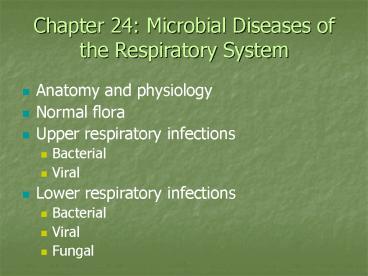Chapter 24: Microbial Diseases of the Respiratory System - PowerPoint PPT Presentation
1 / 30
Title:
Chapter 24: Microbial Diseases of the Respiratory System
Description:
Bordetella pertussis: Gram-negative coccobacillus, encapsulated. Tracheal cytotoxin, ... Features of pertussis. Tuberculosis. Mycobacterium tuberculosis: Acid ... – PowerPoint PPT presentation
Number of Views:326
Avg rating:3.0/5.0
Title: Chapter 24: Microbial Diseases of the Respiratory System
1
Chapter 24 Microbial Diseases of the Respiratory
System
- Anatomy and physiology
- Normal flora
- Upper respiratory infections
- Bacterial
- Viral
- Lower respiratory infections
- Bacterial
- Viral
- Fungal
2
Anatomy and Physiology
3
Characteristics of normal flora
4
Upper respiratory infections
- Bacterial
- Strep throat
- Diphtheria
- Otis media
- Viral
- Common cold
5
Strep throat
- Streptococcal pharyngitis
- Caused by Streptococcus pyrogenes
- Cell envelope components causes virulence
- Severe infections lead to
- Scarlet fever
- Rheumatic fever
- Toxic shock
- Glomerulonephritis
6
Features of strep throat
7
Diphtheria
- Corynebacterium diphtheriae
- Gram-positive rod
- Exotoxin
- produced by lysogenized C. diphtheriae
- Vaccination is available
- DTaP and Td vaccine (Diphtheria toxoid)
8
Features of diphtheria
9
Otitis Media
- S. pneumoniae (35)
- H. influenzae (20-30)
- M. catarrhalis (10-15)
- S. pyogenes (8-10)
- S. aureus (1-2)
- Treated with broad-spectrum antibiotics
- S. pneumoniae infections reduced by vaccine
10
Common cold
- Caused by many different viruses
- Rhinoviruses are the most common
- Can lead to more serious bacterial diseases
11
Features of the common cold
12
Lower respiratory infections
- Bacterial
- Whooping cough
- Tuberculosis
- Pneumonia
- Viral
- Influenza
- Fungal
- Spelunkers disease (histoplasmosis)
- Valley fever (coccidioidomycosis)
13
Whooping cough
- Bordetella pertussis Gram-negative
coccobacillus, encapsulated - Tracheal cytotoxin,
- A B endotoxin
- Stage 1 Catarrhal stage
- Stage 2 Paroxysmal stage
- Stage 3 Convalescence stage
- Prevented by DTaP vaccine
14
Features of pertussis
15
Tuberculosis
- Mycobacterium tuberculosis Acid-fast rod.
Transmitted from human to human - M. bovis lt1 U.S. cases, not transmitted from
human to human - M. avium-intracellulare complex infects people
with late stage HIV infection - Chronic illness
- Remains latent and can be reactivated
- Multi drug resistant
16
Tuberculosis lesion
17
Features of tuberculosis
18
Pneumococcal Pneumonia
- Streptococcus pneumoniae Gram-positive
encapsulated diplococci - Diagnosis by culturing bacteria
- Penicillin is drug of choice
19
Klebsiella pneumonia
- Causes permanent damage to the lung
- Complications lung abscesses, bacteremia
- Plasmids contain resistant genes
- Capsule mucoid colonies
20
Mycoplasmal pneumonia
- Mycoplasma pneumoniae pleomorphic, no cell wall
- Also called walking pneumonia
- Common in children and young adults
- Diagnosis by PCR or by IgM antibodies
21
Bacterial pneumonia
22
Legionnaires disease
- Caused by Legionella pneumophila Gram-negative
rod - Bacterium commonly found in the environment
- Disease due to high infecting dose
23
Features of Legionnaires disease
24
Influenza
- Caused by influenza A virus
- Orthomyxovirus family
- Wide spread epidemics due to antigenic shifts
- Hemagglutinin (H) spikes used for attachment to
host cells - Neuraminidase (N) spikes used to release virus
from cell
25
Antigenic shift
26
Features of influenza
27
Spelunkers disease
- Caused by Histoplasma capsulatum (dimorphic
fungus) - Found in soils contaminated by bat and bird feces
- Occurs in tropical and temperate zones
(b) gt35
(a) 37
28
Features of Histoplasmosis
29
Valley fever
- Caused by Coccidioides immitis
- Initiated by airborne fungal spores
- Tissue injury due to immune response
30
Features of coccidioidomycosis































